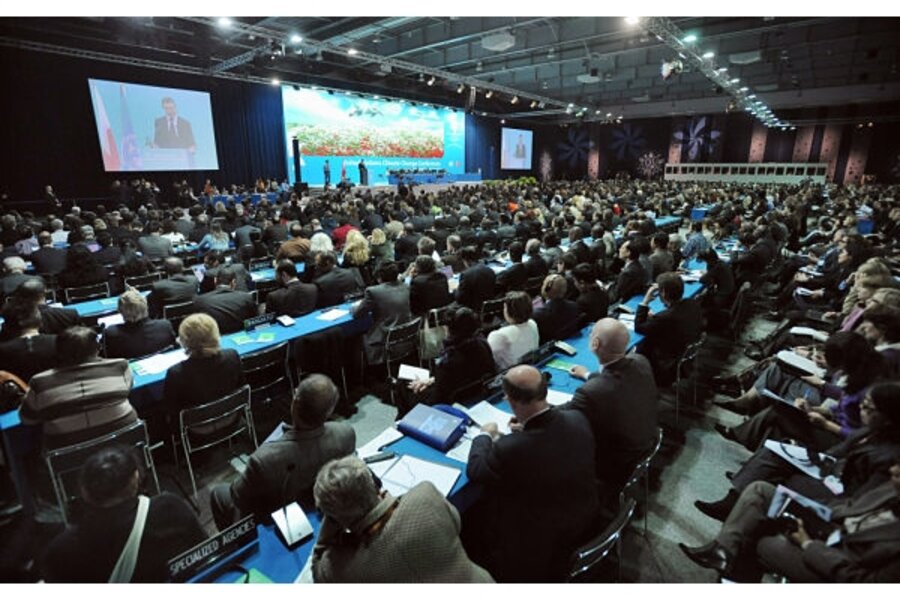A new way for nations to divvy up greenhouse-gas cuts?
Loading...
If you want to see how hard it will be to get the next round of cuts in greenhouse gases in any new global climate agreement, look at what happened today in Italy.
The good news: The G-8 countries declared that they "recognise the broad scientific view that the increase in global average temperature above pre-industrial levels ought not to exceed 2°C." The communique is available in pdf form on the G-8 meeting's website.
The statement is not exactly a hard and fast commitment to shoot for 2 degrees, but at least it acknowledges that the science points to that level as a kind of climatological line in the sand.
But climate talks between developed and developing countries, aimed at feeding into the broader UN negotiating process, fizzled out. Developing countries were unconvinced that their richer counterparts were willing to commit to rigorous mid-term emissions goals in exchange for developing countries backing a global reduction in emissions of 50 percent below 1990 levels by 2050 -- a goal that would require significant participation by developing countries.
Now along comes a team of researchers from the US, the Netherlands, and Italy that offers what it sees as a more equitable approach to divvying up emissions-reduction duties, at least for now.
It's based on a couple of premises: In the end, people as consumers of resources are ultimately responsible for carbon emissions, whether any one person's contribution is high or virtually nil; and all countries have a least some people whose wealth allows them to consume enough to be counted among "high emitters."
So, the argument goes, set a universal per-person emissions cap. (For a look at how they go about this, you can download a pdf of their research paper, which appears in the current issue of the Proceedings of the National Academy of Sciences.)
Instead of haggling over which nations do what, the approach sets each country's national target by estimating how broad a swath of its population collectively exceeds the allowable per-capita emissions cap and by how much. Their "emissions" are derived from a country's population and income distribution figures and carbon-intensity estimates. For every ton of carbon the high emitters exceed the cap, that ton becomes part of the country's emission-reduction target.
Nearly everyone pitches in
Rich countries collectively still shoulder most of the load under this approach initially. But many developing countries still have to do something, because they have high emitters, however few they may be. And successive national targets for developing countries would become more ambitious as global targets tighten over time and the number of high emitters rises with a country's standard of living.
This approach doesn't aim emission-reduction policies directly at high emitters one by one or even as a group. Instead, a country would use whatever internationally agreed-upon, verifiable mix of tools -- say, cap and trade or approaches such as avoided deforestation -- to meet its national emissions-reduction target.
How might it work? The researchers give an example.
Let's say the world had agreed to cut annual carbon-dioxide emissions to 30 billion tons by 2030, starting in 2003. Compared with business as usual by 2030, the team calculates, that's a 30 percent cut, or 13 billion tons. Based on population trends, income distribution, and carbon intensity estimates, that cut translates into an emissions cap of 10.8 tons of CO2 for each person on the planet. For the record, the calculations also yield 1.13 billion "high emitters" globally.
Apply that cap to the estimated distribution of high emitters in each country, and emissions-reduction targets for some big names in the climate-negotiation game look like this, compared with business-as-usual in 2030:
And the cuts are?
Among industrial countries: the US cuts emissions by 55 percent; Japan cuts by 15 percent; Australia/New Zealand cut by 50 percent; Europe collectively cuts by 20 percent; Canada cuts by 43 percent; and Russia cuts by 45 percent.
Among developing countries: China cuts emissions by 25 percent; Mexico cuts by 14 percent; and Brazil and India get a pass for the period.
The team first offered up this approach at global climate talks in Bali in 2007, and received encouragement, said Princeton University physicist Shoibal Chakravarty during a phone chat. He is the lead author on the research paper.
The team acknowledges that nuances must be worked out before anyone could think of considering this approach for a formal treaty.
Still, Dr. Chakravarty says, "It's a very flexible approach. You don't have to bother about negotiating interim targets or a division of labor between countries. Once everybody decides on a global target, this mechanism automatically provides national targets."
A caution
But an approach that may look equitable and fair on the international stage may not play so well domestically.
Raymond Kopp, an economist with Resources for the Future in Washington and a self-described "inside the Beltway guy" offers a note of political pragmatism.
"I appreciate the elegance of these solutions for carving up the emissions of the world," he says, But in the end, politicians in individual countries still determine what they can or can't contribute to the cause -- assuming they agree a cause exists. They are unlikely to yield their roll as decision-makers to a set of mathematical equations, Dr. Kopp suggests.





